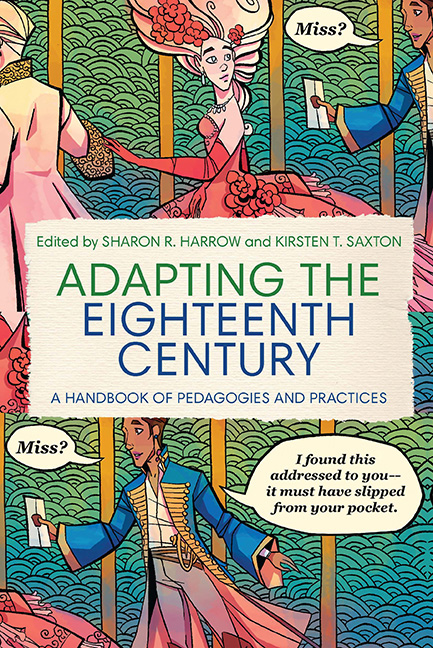Book contents
- Frontmatter
- Dedication
- Contents
- Acknowledgments
- Introduction
- 1 “Je suis Voltaire,” or, Appropriating the Philosophe in the Social Media Age
- 2 “Who Lives, Who Dies, Who Tells Your Story?”: The Uses of Hamilton in Special Collections Pedagogy and Public Engagement
- 3 Performing Frankenstein in the South: Sex, Race, and Science across the Disciplines
- 4 French Fairy Tales and Adaptations in the Twenty-First-Century Classroom
- 5 Select Trials at the Sessions-House in the Old-Bailey (1742) and Mark Ravenhill’s Mother Clap’s Molly House (2001)
- 6 Teaching with The Pilgrim’s Progress Video Game
- 7 Eliza Haywood’s “Bad Habits”: Teaching Adaptations of Fantomina: or, Love in a Maze and The Distress’d Orphan; or, Love in a Madhouse
- 8 Teaching Eighteenth-Century Literature through Eighteenth- Century Adaptations: Adaptive Structures
- 9 “A Private Had Been Flogged”: Adaptation and the “Invisible World” of Jane Austen
- 10 Fifty Shades of Pamela in the Undergraduate Classroom
- 11 Teaching the Austen-Monster-Mashup: Sense and Sensibility and Sea Monsters
- 12 Learning to Adapt: Teaching Pride and Prejudice and Its Adaptations in General Education Courses
- 13 Race and Romance: Adapting Free Women of Color in the Long Eighteenth Century
- 14 The Crusoeiana: Material Crusoe
- 15 Adaptation in Strange Places: Terrence Malick’s To the Wonder and the Narrative Effect and Form of Samuel Richardson’s Pamela
- 16 Adapting the Tombeaux des Princes: A Study in Media Variations
- 17 Experiential Pedagogy to Join the Thread of Conversation with Paul et Virginie
- 18 “Lookin’ for a Mind at Work”: Hamilton, Adaptation, and Enlightenment Ideals for the Core Curriculum
- Notes on the Contributors
- Index
13 - Race and Romance: Adapting Free Women of Color in the Long Eighteenth Century
Published online by Cambridge University Press: 26 April 2020
- Frontmatter
- Dedication
- Contents
- Acknowledgments
- Introduction
- 1 “Je suis Voltaire,” or, Appropriating the Philosophe in the Social Media Age
- 2 “Who Lives, Who Dies, Who Tells Your Story?”: The Uses of Hamilton in Special Collections Pedagogy and Public Engagement
- 3 Performing Frankenstein in the South: Sex, Race, and Science across the Disciplines
- 4 French Fairy Tales and Adaptations in the Twenty-First-Century Classroom
- 5 Select Trials at the Sessions-House in the Old-Bailey (1742) and Mark Ravenhill’s Mother Clap’s Molly House (2001)
- 6 Teaching with The Pilgrim’s Progress Video Game
- 7 Eliza Haywood’s “Bad Habits”: Teaching Adaptations of Fantomina: or, Love in a Maze and The Distress’d Orphan; or, Love in a Madhouse
- 8 Teaching Eighteenth-Century Literature through Eighteenth- Century Adaptations: Adaptive Structures
- 9 “A Private Had Been Flogged”: Adaptation and the “Invisible World” of Jane Austen
- 10 Fifty Shades of Pamela in the Undergraduate Classroom
- 11 Teaching the Austen-Monster-Mashup: Sense and Sensibility and Sea Monsters
- 12 Learning to Adapt: Teaching Pride and Prejudice and Its Adaptations in General Education Courses
- 13 Race and Romance: Adapting Free Women of Color in the Long Eighteenth Century
- 14 The Crusoeiana: Material Crusoe
- 15 Adaptation in Strange Places: Terrence Malick’s To the Wonder and the Narrative Effect and Form of Samuel Richardson’s Pamela
- 16 Adapting the Tombeaux des Princes: A Study in Media Variations
- 17 Experiential Pedagogy to Join the Thread of Conversation with Paul et Virginie
- 18 “Lookin’ for a Mind at Work”: Hamilton, Adaptation, and Enlightenment Ideals for the Core Curriculum
- Notes on the Contributors
- Index
Summary
In American classrooms today, discussions of race during the long eighteenth century almost invariably focus on the transatlantic slave trade. The Norton Anthology of English Literature's companion website, for example, identi- fies one of the key contexts of the period as “Slavery and the Slave Trade in Britain,” and it features images of tortured and enchained black bodies. It links to excerpts from works by John Locke, Hannah Moore, and William Cowper. Similarly, the Broadview Anthology of British Literature's compan- ion website includes Anne Yearsley and Thomas Day to its “Transatlantic Currents: Slavery” materials. The Longman Anthology of British Literature similarly offers the “Abolition of Slavery and the Slave Trade” to its “Perspectives” sections. In each of these examples, the editors and publish- ers have aimed to supplement perspectives offered by the established white male literary canon by including the writings of non-canonical white men and women, as well as those of a few people of color. These few voices are limited to those that describe the experiences of enslaved peoples. According to these curatorial and authorial perspectives, to be black in the eighteenth century was to be either enslaved or to be formerly enslaved, to be passive, to be without agency.
This history is ripe for revision, as demonstrated by Amma Asante's film Belle (2013). In the course Writing Women and Race, one of my colleagues from the History Department—Dr. Elizabeth Manley—and I enabled stu- dents to interrogate the stakes of such revision.
In one portion of this course, my students examined Asante's film along- side Paula Byrne's biography, Belle: The Slave Daughter and the Lord Chief Justice (2014), and the anonymous novel The Woman of Colour (1808). Each of these texts offered alternative narratives of how blackness shaped identity for women of a particular social status, specifically those born in the West Indies to white fathers of enslaved mothers and who travel to England and confront specific economic and political challenges within the marriage mar- ket. Specifically, by interrogating how Byrne and Asante adapt the facts of Dido Elizabeth Belle's life according to the model of Hollywood and BBC Jane Austen, we were forced to consider our own experience of the pleasures of adaptation.
- Type
- Chapter
- Information
- Adapting the Eighteenth CenturyA Handbook of Pedagogies and Practices, pp. 204 - 212Publisher: Boydell & BrewerPrint publication year: 2020



